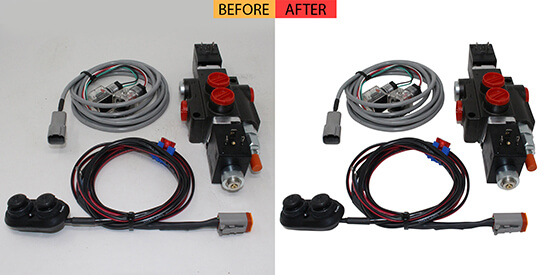Product photo retouching enhances the visual appeal and consistency of e-commerce images. It’s a critical step to ensure products look their best online.
Crafting an excellent online presence is essential for any e-commerce business, and high-quality product images are at the heart of this digital showcase. Product photo retouching is a meticulous process that involves adjusting colors, removing blemishes, and perfecting lighting to make product photos more attractive and trustworthy to potential buyers.
This service is not just about making products look good; it’s about creating a visual that resonates with customers and encourages sales. Whether for an individual seller on platforms such as Etsy, Amazon, or large-scale retail websites, retouched photos represent the quality and detail of the items on offer. As the commercial landscape grows increasingly competitive, professional photo retouching becomes a non-negotiable aspect of digital marketing and branding strategy for businesses aiming for success.
Introduction To Product Photo Retouching
Product photo retouching is an essential process for crafting compelling images for marketing. Through skillful manipulation, professional retouchers enhance the visual appeal of product photos, ensuring they present the items in the best light possible. Retouching maximizes impact, polishing images to a high standard that captivates potential customers.
The significance of presenting high-quality visuals in marketing campaigns cannot be overstated. They can significantly influence consumer decisions, reinforcing brand reliability and product desirability. With eye-catching imagery, businesses stand to entice a larger audience and boost engagement.
Technique Tool Description
- Color Correction Photoshop Adjusting color balances to reflect the product’s true colors.
- Spot Healing Lightroom: Removing blemishes or spots to create a flawless appearance.
- Clipping Paths Illustrator Isolating the product to manipulate the background or context.
A variety of techniques and tools are at the disposal of retouchers—from spot healing to sophisticated color adjustments—providing an array of capabilities for different types of photo enhancements.
Mastering Retouching Techniques
Ensuring color consistency in product images is paramount for maintaining brand integrity. Color correction balances hues and saturation, making colors pop and, more importantly, accurate to the product. Grading goes further to give the images a uniform look and feel across a product line.
The goal of high-quality product imagery is best served by eliminating distractions. Retouching to remove blemishes or imperfections from products involves a keen eye for detail and precision. This process enhances visual appeal and instills customer confidence in the product’s quality.
A clean or appropriately designed background ensures that the product stands out. Techniques such as background cleanup or replacement direct the viewer’s attention to the product, improving the overall composition and focus of the image.
- Shadows: Adding or refining shadows for depth perception and realism.
- Reflections Crafting reflections to emulate different surfaces and create a premium look.
- Highlights Adjusting highlights to accentuate critical features of the product.
The Workflow Of Professional Retouchers
Professional retouchers adhere to a streamlined workflow to enhance productivity and maintain the highest quality in product photo retouching. An essential practice in this process is batch processing, which significantly accelerates the editing phase by applying adjustments to multiple images simultaneously. This technique is particularly beneficial when dealing with large volumes of photographs, ensuring a swift turnaround without compromising precision.
To preserve a cohesive look across various images, consistency is paramount. This is achieved through the meticulous application of uniform editing parameters, which often involves the creation of custom presets. By doing so, each product photo retains a consistent aesthetic that aligns with the brand’s visual identity.
Quality control is the final, critical step in the retouching workflow. Before the final delivery, each image undergoes a thorough inspection to ensure it meets the set standards of perfection. This stage often involves checking for color accuracy, removing any remaining imperfections, and validating that all client specifications have been met.
Essential Tools For Product Photo Retouching
Product photo retouching relies heavily on the right software tools for editing and enhancing images. Adobe Photoshop remains the industry standard with its vast array of tools and functionalities for complex editing tasks. On the other hand, Adobe Lightroom provides photographers with powerful cataloging features and streamlined workflows for batch processing. Alternative options such as GIMP, Corel PaintShop Pro, and Capture One also offer a range of editing capabilities and might better fit specific needs or budgets.
High-quality monitors with accurate color representation are crucial for retouching, ensuring the final image appears consistent across various devices. Using a graphics tablet can significantly improve editing precision over a traditional mouse. Tablet accessories like pressure-sensitive stylus pens add finer control to retouching tasks. Calibrating these devices regularly is essential to maintaining color accuracy and editing efficiency.
Utilizing plug-ins and presets can dramatically speed up the retouching process. In some cases, they provide a starting point or even a one-click solution, especially for repetitive tasks or to maintain a consistent style across a series of images. Determining when to use them depends on the project’s requirements and the desired level of customization.
Ethics And Misconceptions In Retouching
Balancing the line between enhancing product images and maintaining authenticity poses a significant challenge. Product photo retouching is a powerful tool for illuminating product features, yet it treads a fine line that may lead to ethical dilemmas. Too much alteration can result in a misleading representation of the product, causing consumer disillusionment when the item fails to match its online image.
The debate around misrepresentation in product advertising is heated, with standards and regulations often guiding what is acceptable. Enforcement agencies can penalize companies for deceptive practices, necessitating a balance. Retouchers should strive for corrections that reflect the product’s true nature, avoiding drastic changes that could deceive customers.
Setting realistic expectations is imperative for customer satisfaction and brand integrity. Transparency about the extent of photo modifications can cultivate trust and respect between consumers and businesses. Providers of retouching services must also communicate with clients about the ethical implications to ensure shared values in the portrayal of products.
Advanced Topics In Product Photo Retouching
3D retouching for product visualizations has revolutionized the way products are presented online. Utilizing advanced software, graphic designers can create lifelike and highly detailed 3D models of products. These models can be manipulated in real-time, allowing for interactive demonstrations. Customers can view products from every angle, enhancing their shopping experience.
Integrating animation and interactive imagery into product photos takes engagement to a new level. Such dynamic visuals can display a product’s functionality, simulate its use, or simply bring an otherwise static product to life. This approach not only increases the attractiveness of the product but also boosts consumer interaction.
Integrating AI and machine learning into retouching practices marks a new era for product photography. These technologies promise to streamline the editing process, reduce turnaround times, and enhance the accuracy of retouches. AI algorithms can learn from vast datasets of images to predict optimal enhancements for a given product, catering to specific aesthetics and themes with unprecedented precision.
Building A Portfolio And Gaining Clients
Launching a successful career in product photo retouching necessitates showcasing your best work through a well-curated portfolio. Highlight before and after transformations to demonstrate the impact of your skills. Tailor content to display a variety of product genres to attract a diverse client base. Ensuring high-quality images that represent your attention to detail and consistency will set a professional tone.
Engaging e-commerce and retail businesses begins with strategic marketing. Use social media platforms to showcase your retouching work and network with industry professionals. A strong online presence through an SEO-optimized website can attract potential clients, emphasizing the value-add you bring to their visual content. Direct outreach to businesses and online advertisements can increase your service’s visibility.
Success in client management hinges on fostering trustworthy relationships. Clear communication, prompt delivery, and consistent quality are pillars of long-term collaborations. No-table understanding of a client’s brand and audience can help tailor your services for further engagement and referrals.
Conclusion: Elevating Your Brand With Quality Retouching
Quality product photo retouching significantly elevates a brand’s visual appeal, ensuring the products showcased resonate with consumers. Engaging professional retouching services can dramatically enhance imagery, providing a competitive edge in today’s visually-saturated market.
Exploring a series of case studies reveals the transformational benefits of high-quality retouching. Numerous brands have witnessed remarkable success, with improved product images leading to increased sales and customer engagement. Testament to this is the compelling success stories that underline the importance of investing in skilled photography editing.
Embracing continued learning and adaptation remains crucial in the dynamic field of photo retouching. Industry professionals constantly advance their craft, keeping pace with the latest technologies and trends. This commitment to growth ensures brands can consistently showcase their products in the best light.
Frequently Asked Questions On Product Photo Retouching
What Is Product Photo Retouching?
Product photo retouching involves enhancing and editing images to improve their quality for marketing and sales purposes, typically for e-commerce and advertising.
How can I edit my product photos?
To edit your product photos:
- Use photo editing software like Adobe Photoshop or free tools like Canva and GIMP.
- Adjust brightness and contrast, and remove backgrounds to enhance the image.
- Consider hiring a professional for quality results.
How Much Do You Charge for Photo Retouching?
Our photo retouching services start at $5 per image, with prices varying based on complexity and volume discounts.
What Is the Difference Between Photo Editing and Retouching?
Photo editing involves altering the composition of an image, such as cropping, color adjustments, and filters. Retouching is a more detailed process, focusing on correcting imperfections and enhancing features in a photo, like smoothing skin or sharpening details.
Conclusion
Product photo retouching is vital for any business aiming to showcase products impressively. The right retouch can transform images into powerful sales tools, smoothing out imperfections and enhancing colors. Invest in quality retouching to ensure your visuals stand out and captivate your audience, driving those crucial conversions.



